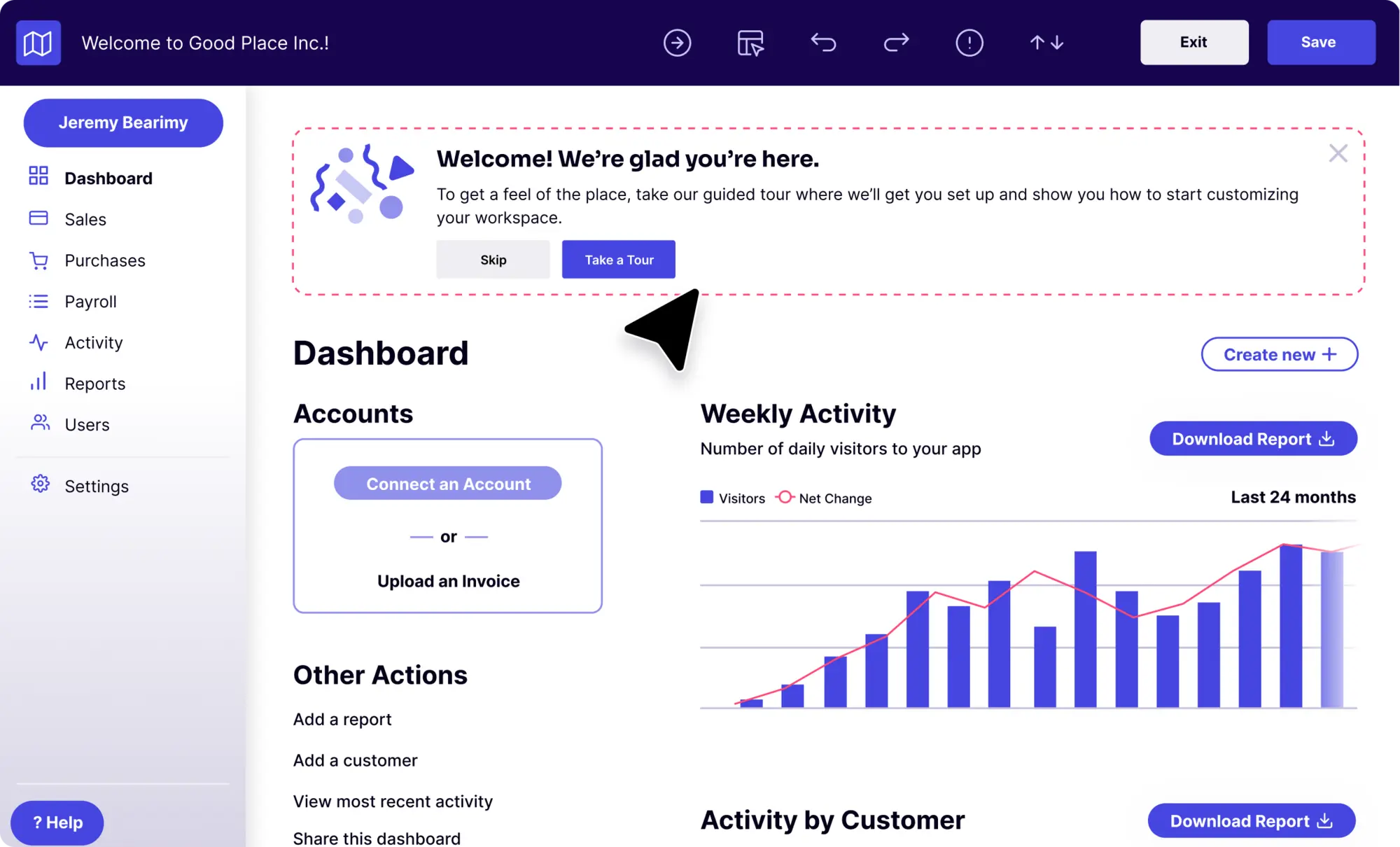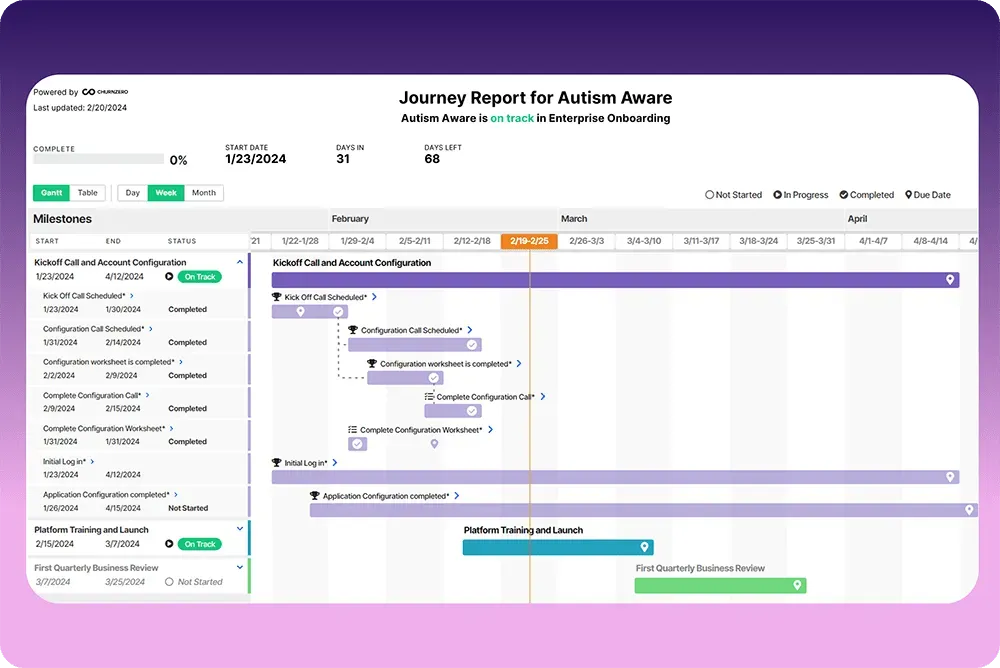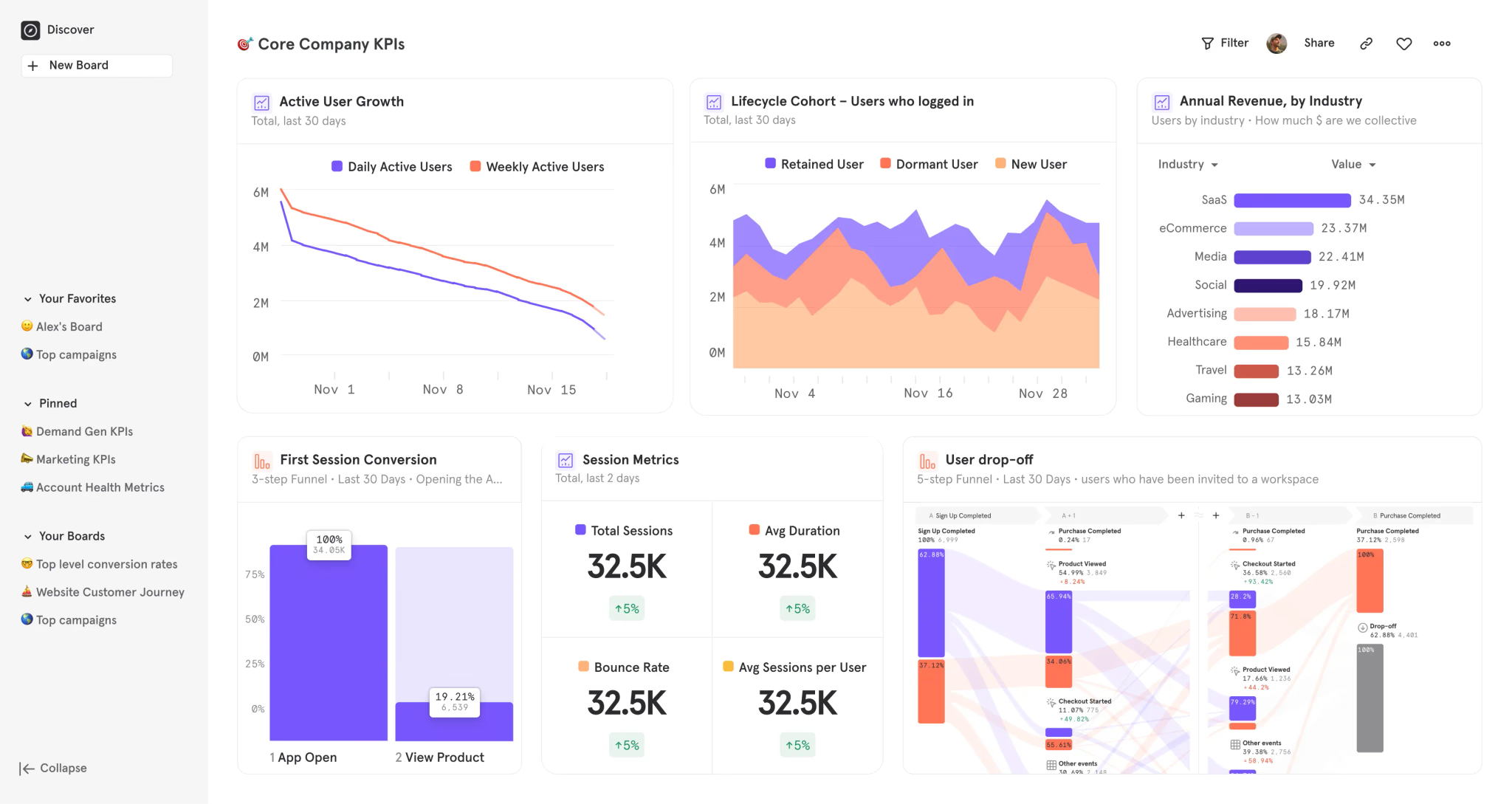Product
TABLE OF CONTENTs
TABLE OF CONTENT
Your six-figure customer signed three months ago.
Today, only 12 of their 30 licenses sit active. Usage reports read like an ECG flatline.
And that super-eager internal champion during the sales cycle? She’s MIA.
If your Customer Success team struggles with adoption like this, we hear you.
This guide will provide you with proven customer adoption strategies, metrics, and software to increase engagement, expansion, and, ultimately, renewal.
What is customer adoption?
Customer adoption is when customers use your product consistently and depend on it to run part of their business.
In practice, adoption shows up in three ways:
- Customers are engaging with your core features on a regular cadence
- They’re expanding usage across teams and features;
- And they’re investing more through renewals or upgrades.
Strong adoption means the product is embedded deeply enough that replacing it would create operational risk.
Some common signals of adoption include:
- High and steady usage of core features
- Expansion into secondary features or modules
- Seat growth beyond the original user group
- Upgrades to higher tiers or add-ons
- Champions inside the account who drive adoption with their peers
Why does customer adoption matter for SaaS companies?
Customer adoption rates determine your company's growth trajectory. If your company has high customer adoption, you can likely count on predictable expansion revenue through additional licenses, automatic renewals, and word-of-mouth referrals.
But if your customer adoption is low, you’ll burn through cash trying to replace churned accounts.
For Customer Success teams, keeping an eye on customer adoption gives insight into which accounts will renew versus which need intervention. This visibility enables proactive strategies that prevent churn before renewal conversations begin.
The customer adoption lifecycle
Knowing where a customer sits in the customer adoption lifecycle helps CS teams take the right actions to deepen product engagement and reduce churn risk.
Strong onboarding drives stronger adoption, and strong adoption makes renewals and expansions far more likely.
So let’s understand the key stages along the lifecycle:
Pre-sale stages
Most SaaS organizations master these pre-sale stages. But, they often overlook how these early interactions directly influence long-term adoption.
Every claim Sales makes sets expectations that CS must eventually deliver against.
1. Awareness
Awareness begins when a prospect realizes they have a pain point they need to solve. This includes both problem recognition and product awareness—understanding that solutions exist to assist with their specific challenges.
2. Consideration
Consideration follows as the prospect begins product evaluation of several solutions. It’s during this stage that they decide on their new product’s must-haves and the pricing they’re willing to pay for those features and functionalities.
3. Evaluation and Decision
Evaluation and Descision bring stakeholder committees together to review vendor demos and business cases. Success at this evaluation stage ends with that sweet, signed contract (the decision).
While Marketing and Sales typically manage these early stages, they are crucial to Customer Success once they take the baton.
The stakes here are higher than most CS teams realize. Erica Favorito, Founder/Principal of Slice Advisory, explains why sales promises directly determine adoption success:
“The involvement of those customers responsible for adoption are essential stakeholders in the sales process. They should also be educated—in detail—about what they need to do to prepare. Many sales teams gloss over this part because they want to make it seem easy or will overstate what onboarding or CS teams are resourced to do. This just causes unmet expectations and churn later on.”
One idea to prevent unrealistic promises is for the CSM to join key late-stage sales calls. If Sales makes promises that stretch beyond your team's abilities, the CSM can gently put guardrails on the promise or offer a more doable alternative.
And having CS join sales calls also sends a strong signal that customers will get a white-glove customer experience.
Post-sale stages
Customer Success drives the final three stages of the customer adoption process.
Each stage connects to the next: Momentum from the onboarding process fuels adoption, and strong adoption makes renewal conversations a sure thing.
4. Onboarding & Implementation
Customer onboarding is a streamlined, systematic process that gets new customers into the software. During this stage:
- Teams configure software settings to match existing workflows
- Key stakeholders receive role-specific training sessions
- Technical teams establish integrations with current systems
- Champions identify and document initial success metrics
- Customer Success managers establish regular check-in cadences
Success at this stage happens when a customer’s time to first value comes quickly after being introduced to your software.
5. Adoption
Adoption represents the make-or-break moment(s) where usage becomes habitual. It’s when the switch flips from “I’m getting the hang of this” to “OMG I can't imagine working without it.”
It’s not just one individual who sings your platform’s praises at this stage. Adoption grows consistently across the team of users. This stage separates customers apt to renew from those likely to churn.
6. Renewal
Renewal and Expansion reward strong adoption with continued partnership.
At this stage, teams see loyal customers embed their solution into their operations, naturally expand their usage, add more seats, and often become vocal advocates for your product.
Customer adoption metrics to track
The right adoption metrics provide early warning signals before renewal conversations begin. Customer success teams use the KPIs in this section to calmly and proactively prevent churn (instead of frantically reacting to it).
Onboarding metrics
Brittany Soinski at Atlassian explains why tracking customer onboarding metrics matters:
“Our research shows that if we can get people on this adoption curve during the onboarding period—within the first 30 or 60 days—they're going to see long-term success and renew with our tool. It's really hard to re-activate or re-onboard somebody down the line.”
Here are a few KPIs to track adoption during this timeframe:
1. Time to first value
Measure how quickly customers hit their first meaningful outcome. Extended delays often mean any initial enthusiasm has faded.
Could that be because they can’t figure out how the software will improve their daily workflows? Or have they been overwhelmed with something entirely different at work, like an upcoming presentation? Check in and find out.
2. Implementation velocity
We all love onboarding checklists, but consider tracking the pace of milestone progression rather than individual task completion.
Consistent forward movement indicates a strong internal commitment to using your software. But noticeable gaps typically indicate internal roadblocks that you’ll want to know about.
3. Onboarding engagement rates
Track who views implementation materials and how thoroughly they engage with them. If you see solid stakeholder participation, that signals strong internal buy-in. A great start!
But if you observe low engagement, this predicts adoption struggles ahead.
Usage metrics
When you track usage patterns, you begin to see the divide between customers building sustainable habits and those not finding their footing in your software. Monitoring the following adoption metrics will uncover both successful implementations and potential churn risks.
Monica Perez, Head of Customer Success at Notion, explains the importance of staying on topic of usage metrics:
“We measure a lot, updated daily…We’re able to see fluctuations early. Even things like, did they add or remove a bunch of seats overnight? Did they remove a bunch of seats overnight?... The data drives which engagements we pick and choose.”
4. Active user growth
Monitor weekly active user growth during the first 90 days. Steady growth signals momentum toward adoption. Flat numbers = time to book a call with the customer.
5. Seat utilization rates
Watch the gap between purchased licenses and active users. Low activation rates often predict downsizing conversations at renewal.
6. Core feature adoption
Determine which product features drive retention rates for your best customers. Then, track how new customers engage with these same features. Are new customers not picking up these features the same way? Find out why.
7. Usage consistency patterns
Look for predictable usage patterns that match business use cases. Sporadic access or patterns that don’t match use cases indicate lack of adoption.
8. Integrations and connections
Track active integrations and data flow. The more a customer’s workflow and systems are linked to your software, the harder (and more expensive) it is for them to switch to an alternative solution.
Making it hard to switch sounds a bit like a Mr. Burns move, but there’s no way around it. The stickier your software is, the higher the chance for customer adoption.
Business impact metrics
Business impact metrics connect product engagement to revenue outcomes. These KPIs demonstrate adoption success to leadership while revealing which customer behaviors drive growth.
9. NPS or CSAT during onboarding
Start surveying customers early on. Early customer satisfaction scores, measured by either NPS or CSAT, predict long-term relationship health better than most post-implementation surveys.
10. Renewal rates by adoption cohort
Segment customers by their adoption patterns—heavy feature users versus light users, early adopters versus delayed implementers—then compare their renewal rates. This analysis reveals which adoption behaviors predict long-term customer retention rates.
Amanda Wade, Customer Success Manager at Agorapulse, stresses the importance of renewal rates, but tracks it somewhat differently:
"Having long-term, loyal clients comes with the benefit of not only a great retention rate, but also clients that grow with your business and product creating more of a mutual partnership as time goes along.
To measure this, we use Net Retention Rate (NRR) so we can better understand the stability of our existing client base, project future growth, and analyze product-market fit.”
11. Expansion revenue
Follow post-contract purchases from existing customers. Think extra seats, premium features, or upgraded plans. Which purchases correlate with expansion decisions? Figure out ways to better offer these extras to new customers.
Tactics for driving customer adoption
Sustainable customer adoption depends on how well you guide customers. From kickoff discovery to implementation execution and long-term engagement, each phase presents opportunities to reduce friction, uncover insights, and deepen product use.
Kickoff phase: establish the framework for smooth adoption
During the kickoff phase, nailing logistics is important.
But strategic discovery is even more vital.
Adoption success requires gathering customer intelligence and conducting deep discovery to reveal organizational dynamics that can impact the customer adoption process.
1. Capture everything at the sales-to-success handoff
Incomplete handoff information kills adoption momentum before customers even get started. Don’t let this happen to you.
Build a standardized handoff template that captures the intelligence your CS team needs:
- Stakeholder dynamics: Who holds budget authority? Who influences the buying decision? Which departments resist change?
- Success criteria: What metrics matter to their executives? How do they define "working"?
- Sales promises: What timeline commitments were made? Which features were positioned as must-haves?
- Organizational context: Current tech stack, change management history, competing priorities
2. View kickoff sessions as discovery goldmines
Sure, your kickoff call should cover timelines and logistics. But don’t leave the session without diving deep into discovery.
Dig into operational realities by asking the following questions:
- “Walk me through your current approval process for new tools.”
- “How does your team typically learn new workflows—formal training, peer mentoring, or trial-and-error?”
- “What's your standard timeline for rolling out changes across departments?”
- “Which existing tools would this need to integrate with day-to-day?”
During your kickoff sessions, be sure to map stakeholder patterns. But note: the patterns might not start with your buyer champion.
The executive who championed your purchase during the pre-sale stages might now delegate oversight to a colleague. (Or worse, your buyer champion might have been laid off or voluntarily moved to another company.)
Track any transitions and adjust your engagement accordingly.
Execution phase: drive implementation momentum through structured delivery
Most onboarding processes fail because they prioritize process over progress. Let's flip that script by making every interaction drive toward measurable adoption milestones.
1. Create a centralized onboarding hub
Consolidate materials in one accessible location. When customers hunt through email attachments, Slack threads, and project management boards for implementation requirements, friction kills momentum.
Dock's customer onboarding software consolidates project plans, training materials, documentation, and communication threads on its client-facing workspace. No more hunting through email attachments or navigating multiple platforms.
Our free onboarding template lets CS teams launch organized implementations without building workflows from scratch. Each customer gets a personalized hub that automatically populates with their company details, stakeholder information, and customized timelines.
Check it out:
This centralization eliminates the friction that kills onboarding momentum. When customers know exactly where to find what they need, they progress faster through implementation milestones.
2. Engineer change management success
The biggest onboarding failures happen when CS teams ignore organizational inertia.
To prevent this, Customer Success must actively support internal champions in driving change throughout their organization.
Remember those champions you mapped out in the onboarding phase? They're navigating skeptical colleagues, entrenched processes, and organizational politics that aren’t visible on Zoom check-ins.
Arm them with presentation-ready success stories, ROI calculations, and department-specific use cases they can share with holdouts and promote change management from inside their company.
3. Plan for phased implementation
As tempting as it might be for Customer Success to show All The Things to new customers, it’s best to start small and with a phased implementation plan.
Begin by identifying a workflow that drives immediate, measurable impact. Secure adoption there before introducing additional capabilities. This creates internal dopamine that fuels broader implementation.
4. Encourage asynchronous onboarding
Live training sessions feel like white-glove service, but they're expensive and often ineffective for lasting behavior change.
On Grow & Tell, Rachel Provan, CEO and Founder of Provan Success, explains the training retention challenge:
“We forget 90% of any trainings or instructional content within 24 hours. But people don't like to admit, 'I completely forgot what you told me yesterday, and I don't know what I'm doing.' People aren't comfortable saying that.”
Instead, move toward asynchronous onboarding models. Self-paced materials allow customers to revisit concepts as needed, reducing the pressure to absorb everything during live sessions.
Dock's client-facing workspaces enable this approach by letting customers progress through materials independently while maintaining central progress tracking.
Ongoing phase: maintain long-term adoption
Adoption doesn't end when implementation is complete. Nor does it end once a customer finds first value. As we’ve discussed, customer adoption is an ongoing process.
Here are some ways to consistently drive adoption across this continuum.
1. Meet customers in their daily workflow
Nudge customers where they work in your tool. Use in-app notifications and embedded guidance to minimize friction while maintaining customer adoption momentum.
Timing is key with these touch points, so set up communication triggers based on customer behavior. For example, if a customer completes their first successful workflow in a new feature, that's the moment to send a message with a “tada!” emoji 🎉 and suggest the next logical step.
2. Build a proactive track-and-nudge strategy
We’ve talked about the importance of proactively monitoring KPIs that predict churn rate risks before they materialize.
Dock's engagement analytics reveal which customers access materials and how long they spend reviewing content.
The platform tracks engagement at the stakeholder level, showing you which decision-makers are involved and which ones need additional attention.
Use these insights to trigger targeted interventions:
- Low platform access: Chat about potential competing priorities
- High platform usage but feature avoidance: Investigate timing or use case mismatch
- Declining champion engagement: Refresh your stakeholder map
7 tools for improving customer adoption
The right software stack eliminates adoption guesswork by providing data-driven insights into customer behavior, engagement patterns, and success indicators.
Here are seven platforms that successful CS teams use to drive measurable adoption results:
Customer onboarding portals
1. Dock
Unlike generic project management tools or customer success platforms, Dock specifically addresses the client-facing onboarding experience. Our platform creates branded, personalized workspaces that make customers feel supported rather than managed.
Key adoption benefits of Dock's onboarding workspaces include:
- White-glove presentation: Customers receive professional, branded portals
- Self-service enablement: Comprehensive resource libraries reduce support tickets and accelerate progress
- Stakeholder engagement tracking: Understand who's involved and who needs attention
- Template-driven consistency: Every customer receives the same high-quality experience regardless of their CSM.
When Brittany Soinski was the Manager of Onboarding at Loom, she saved two hours per customer onboarding using Dock's templated approach.
Product adoption platforms
2. WalkMe
WalkMe provides in-app guidance that walks users through complex workflows without needing customer success training sessions. This way, customers face a shorter learning curve to understand new features and processes.
3. Pendo
Pendo combines in-app guidance with product analytics to help teams understand how customers navigate their software.

With Pendo’s analytics, teams can identify where users struggle, then deploy targeted guidance. This data-driven approach helps prioritize which features need better onboarding support and creates a more intuitive customer experience.
Customer success software
4. Gainsight
Gainsight operates as a command center for customer success teams managing complex relationships.
The platform pulls customer data from multiple sources into unified health scores, automated playbooks, and risk identification systems. Teams can intervene proactively before issues escalate to churn risks.
5. ChurnZero
ChurnZero focuses on subscription businesses that need to monitor customer health indicators and automate customer engagement campaigns.
The platform tracks usage patterns, identifies at-risk accounts, and triggers personalized outreach based on behavioral triggers.

Teams managing high-volume SaaS customers value ChurnZero's automated playbooks that scale personal attention and connect product usage data with customer success actions.
Analytics and product usage tools
6. Heap by Contentsquare
Heap captures every user interaction within web and mobile applications without needing manual tracking setup. This approach eliminates data collection gaps.
Product teams use Heap to understand complete user journeys, from initial signup through product adoption. The platform's retroactive analysis capabilities help uncover patterns that drive customer success.
7. Mixpanel
Mixpanel specializes in event-based analytics that track specific user actions. This approach shows how customers progress through onboarding funnels and which features correlate with long-term retention.

Customer success teams use Mixpanel's cohort analysis to understand how different user segments behave over time. The platform connects specific product interactions with business outcomes.
Improve customer adoption with Dock
Growing customer success teams need onboarding platforms built for today's B2B customer. This means driving adoption through data-driven insights and seamless customer experiences.
Dock connects your CS processes and customers in one workspace where meaningful progress happens, from initial implementation through expansion conversations.



























.webp)
.webp)
.webp)






